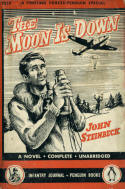 |
Infantry Journal Penguin S-series Superior Reprints |
|
|
|
Ian Ballantine, Penguin's chief of their U.S. operation, was a savvy businessman, as well as a tremendous judge of what the American public wanted in the way of literature. When America suddenly found itself embroiled in the same war that England was so valiantly fighting, he knew he must take immediate and dramatic measures. First, the American public would be thirsty for war news and military issues. But most important, there was sure to be a shortage of paper (keep in mind that England had been dealing with wartime shortages for more than two years already). Ballantine struck a deal with the Military Service Publishing Company. If war is hell, then this was the closest thing to a match made in heaven. Penguin would provide the books, the army would supply the paper and agree to purchase a large percentage of the volumes. Penguin (at least the American branch) went into the war a modest, struggling publisher; but it emerged, thanks in large part to this deal, as an extremely strong player in the paperback industry. After its transition to New American Library (Signet), it would eventually become the largest in America. The first books were literally put together on Ballantine's kitchen table. He designed the cover for What's That plane? (Penguin S201); his wife, Betty, did the layout; and Walter Pitkin wrote the text, while HIS wife traced silhouettes from a British Information Service document. Most of Penguin's S-series run of books sported the orange background color of Penguin's "Special" series that had long been a part of wartime England. But the Infantry Journal Press also put out its own books, most of which matched Penguin's size and style. While the "Special" series, distributed as a joint Penguin/Infantry Journal publication, is clearly numbered, those books with only the Infantry Journal logo had no numbering whatever. It's very difficult to figure out which books came first. And more to the point, I can't find any source that even comes close to listing them all. Most of the price guides list only a few. Piet Schreuders, in his book, guesses that there were "about 75" of them. The Fighting Forces Series was like the Armed Services books; that is, they were printed solely for use by soldiers, and were not sold to the general public. There are only two, actual, stated, numbered Infantry Journal books: J101, and J102. Ballantine took copies of J101 with him when he left Penguin and reissued them as Bantam #156 after wrapping them in dust jackets. (He did the same with other books he printed for the joint-use projects, including several Superior Reprints). The Superior Reprints were printed in Harrisburg, Pennsylvania by the Military Service Publishing Company in association with Penguin. The titles were designed to be easy reading for the troops (though they were sold to the public), and were written by some of the most popular authors of the time. The project ran from 1944 to 1945. There were only 21 of them. For further info, please see: Penguin
This page was updated in June, 2022
|